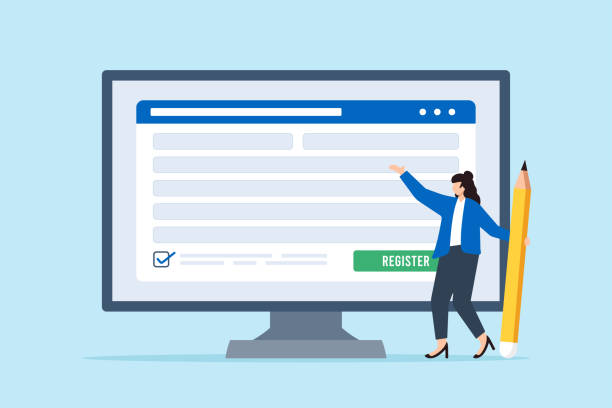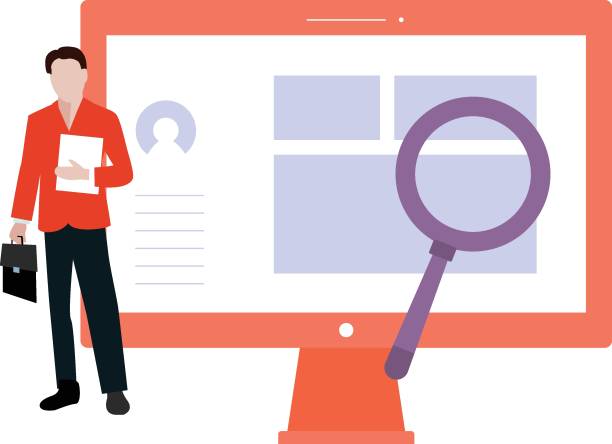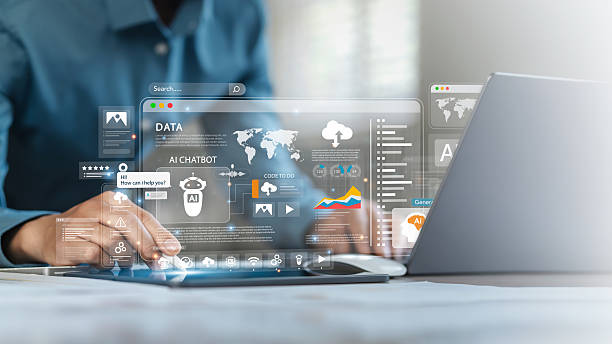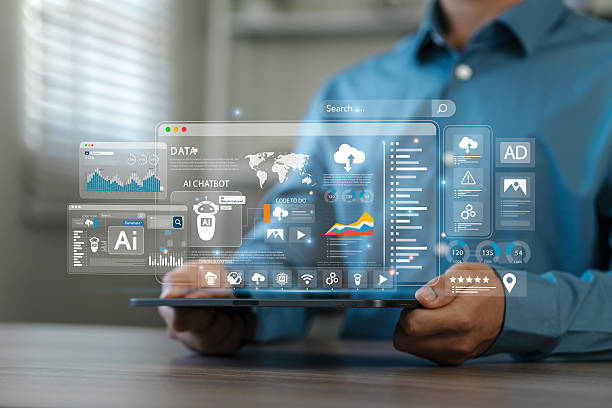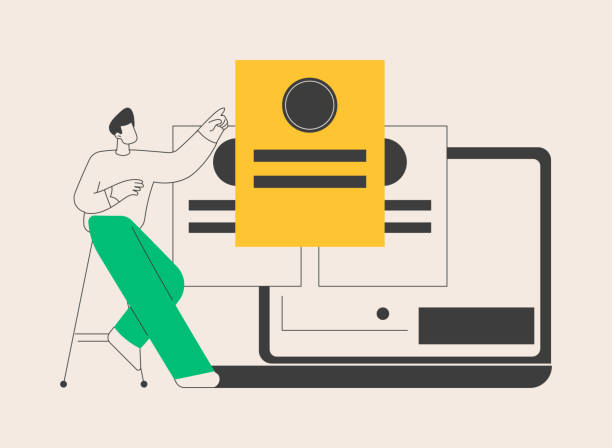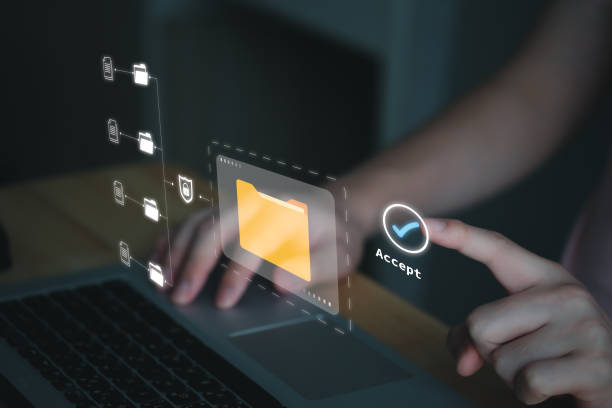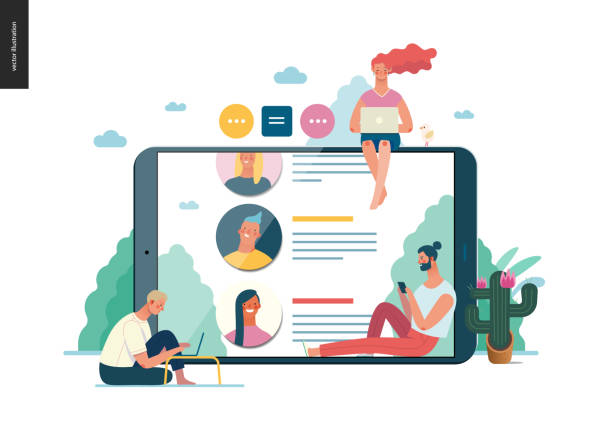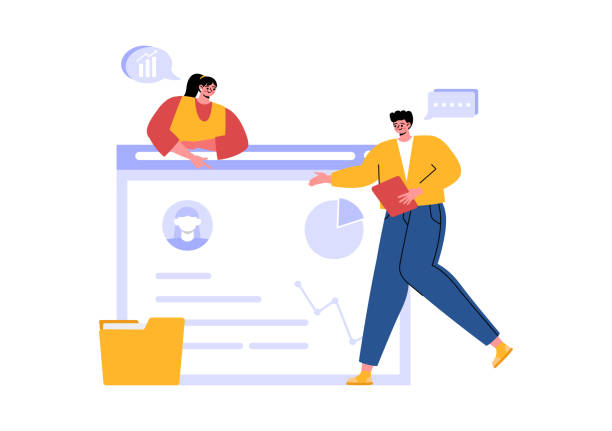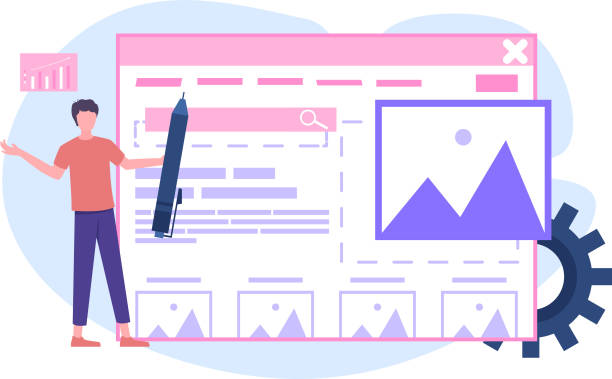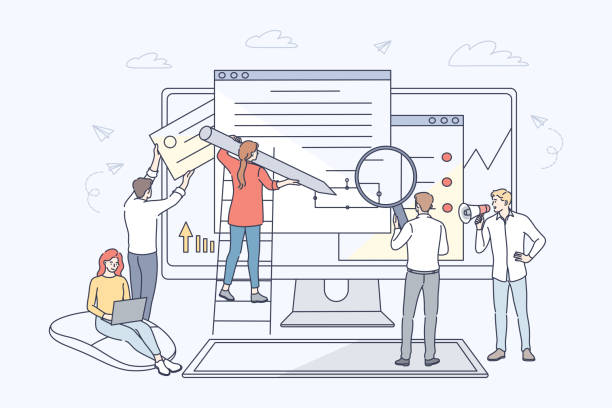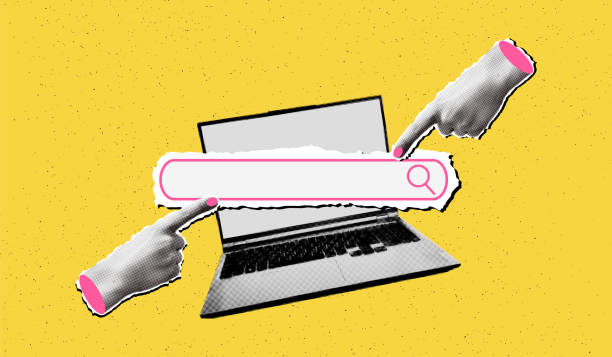Introduction to Modern UI Website Design
Today, in the highly competitive digital world, simply having a website is not enough; what matters is the quality and user experience of that website.
Modern UI website design means creating an online space that is not only visually appealing but also intuitive, easy to use, and enjoyable for users.
This approach goes beyond mere aesthetics and focuses on user needs, behaviors, and expectations.
The main goal in #ModernWebsiteDesign is to provide an unparalleled user experience (UX) and an efficient, eye-catching user interface (UI).
This paradigm transforms your website from a mere catalog into a powerful tool for interaction and converting visitors into customers.
The #ImportanceOfUXUI and its #RoleInDigitalMarketing are evident to everyone.
An old and complex website design can quickly bore users and lead to a high Bounce Rate.
In contrast, a website meticulously built with the principles of modern UI website design can significantly help increase user retention time, improve search engine rankings, and ultimately boost conversion rates.
This approach is a long-term investment for any business that wants to have an effective and powerful online presence.
Is your current e-commerce website not generating the sales you expect?
Rasweb is a specialist in professional e-commerce website design!
✅ An attractive and user-friendly website aimed at increasing sales
✅ High speed and security for an ideal shopping experience⚡ Get a free consultation for online store design with Rasweb!
Principles and Fundamentals of User Experience (UX) in Modern Design
User Experience (UX) is the core foundation of any modern UI website design.
UX refers to the user’s feelings and perceptions when interacting with a product or system.
In web design, this includes all aspects of user interaction with your website, from ease of navigation and finding information to loading speed and accessibility.
Key UX principles include Usability, Efficiency, Satisfaction, and Accessibility.
For example, a modern website should be easily usable by users of all ability levels, even those with disabilities.
User research, including questionnaires, interviews, and A/B tests, plays a vital role in understanding user needs and behaviors.
This specialized approach allows us to design websites that not only look beautiful but also effectively serve user and business goals.
User Interface (UI) and its Role in Visual Appeal
While UX addresses the overall user experience, User Interface (UI) pertains to the visual and interactive aspect of the website.
UI includes all graphical elements with which the user interacts: buttons, icons, images, typography, colors, and overall layout.
A successful UI is not only beautiful but must also be intuitive and understandable so that the user can easily interact with it.
In modern UI website design, the focus is on creating a consistent and cohesive visual language that reflects brand identity while providing a clear path for the user.
Appropriate use of white space, clear visual hierarchy, and a harmonious color palette are among the strategies that help improve UI.
Professional UI design can significantly impact a user’s perception of the website’s credibility and quality.
| UI Element | Description | Impact on User |
|---|---|---|
| Typography | Font selection, size, weight, and line spacing | Readability, tone, and brand personality |
| Color Palette | Selection of primary and secondary website colors | Emotions, visual focus, aesthetics |
| Icons and Images | Visual symbols and supporting graphics | Quick recognition, visual appeal, easy understanding |
| Layout | Arrangement of elements on the page | Ease of navigation, information hierarchy |
| White Space | Empty spaces between design elements | Reduced clutter, improved readability, focus on content |
New Trends in Modern UI Website Design
The world of web design is rapidly evolving, constantly witnessing the emergence of new trends that enhance the user experience.
One such trend is minimalist design, which emphasizes simplicity, the removal of unnecessary elements, and a focus on core content.
This approach is particularly popular in modern UI website design for creating a clean and calming space for the user.
Another trend is the use of Dark Mode, which is not only easier on the eyes in low-light environments but also helps save battery on OLED devices.
Micro-interactions, such as visual feedback when clicking a button or small animations when scrolling the page, add more depth and engagement to the user experience.
Responsive Design is no longer an option but a necessity; the website must display flawlessly on all types of devices, from desktops to mobiles and tablets.
These trends are all aligned with the ultimate goal of modern UI website design: to create a seamless, enjoyable, and efficient experience for all users.
Does your company’s website perform as well as your brand deserves? In today’s competitive world, your website is your most important online tool. Rasweb, a specialist in professional corporate website design, helps you to:
✅ Gain customer credibility and trust
✅ Convert website visitors into customers
⚡ Get a free consultation!
Advanced Website Design Tools and Technologies
To achieve modern UI website design, designers and developers require a set of advanced tools and technologies.
In the design and prototyping section, software such as Figma, Adobe XD, and Sketch are powerful tools that enable UI design, wireframing, and the creation of interactive prototypes.
These tools allow designers to quickly test their ideas and get feedback.
In the development section, programming languages like HTML, CSS, and JavaScript are the backbone of every website.
Using modern JavaScript frameworks such as React, Vue.js, or Angular allows developers to build dynamic and complex user interfaces with high performance.
Content Management Systems (CMS) like WordPress or headless CMSs also play a significant role in building and maintaining modern websites.
The right choice of tools and technologies can accelerate development while ensuring the final product’s quality.
Click here to preview your posts with PRO themes ››
Optimization for Speed and Performance in Modern Websites
Website loading speed is a critical factor in user experience and search engine ranking.
A slow website drives users away and can harm your brand.
In modern UI website design, performance optimization should be considered from the outset.
This includes optimizing images (compression without quality loss), using a CDN (Content Delivery Network) for faster content delivery, caching data and code, and minimizing JavaScript and CSS code.
Google’s Core Web Vitals, such as LCP (Largest Contentful Paint) for loading speed, FID (First Input Delay) for interactivity, and CLS (Cumulative Layout Shift) for visual stability, are important metrics that must be observed in design and development.
Adhering to these principles not only helps improve user experience but also increases website SEO and consequently attracts more traffic.
Responsive Design and Seamless User Experience Across Devices
With the increasing use of diverse devices to access the internet, Responsive Design is no longer a luxury choice but an undeniable necessity in modern UI website design.
A responsive website automatically adjusts its content and layout to the user’s device screen size, meaning your website will display optimally on desktops, laptops, tablets, and smartphones.
This approach ensures that users, regardless of the device they use, will have a seamless and optimized experience.
The “Mobile-First” approach, where design is first done for mobile devices and then for larger displays, has become an industry standard.
This helps designers focus on essential elements and prevent excessive clutter on small screens.
Proper implementation of responsive design not only improves the user experience but also aids in website SEO, as search engines prefer mobile-friendly websites.
| Advantage | Description |
|---|---|
| Improved User Experience | Consistency and ease of use across all devices, reduced bounce rate. |
| Increased SEO Ranking | Search engines rank mobile-friendly websites higher in search results. |
| Reduced Development and Maintenance Costs | Need to develop and maintain only one version of the website instead of several separate versions. |
| Increased Conversion Rate | Positive user experience leads to a higher likelihood of completing forms, purchasing, or signing up. |
| Increased Accessibility | Enables access for a wider range of users with different devices and abilities. |
Security and Stability in Modern Website Design
In addition to aesthetics and performance, security and stability are two vital factors in modern UI website design.
With increasing cyber threats, protecting user information and preventing malicious attacks are of paramount importance.
Using HTTPS protocol (indicating a secure connection), data encryption, and regular updates of systems and plugins are among the essential measures for website security.
Furthermore, attention must be paid to the website’s stability over time.
This means using clean and maintainable code, choosing a reliable hosting provider, and having a regular backup plan.
A website that constantly faces security issues or downtime quickly loses the trust of users and search engines.
A modern and successful website design is not limited to its appearance; it must also be equipped with robust infrastructure and comprehensive security measures to provide stable and reliable performance in the long run.
Does your company’s website perform as well as your brand deserves? In today’s competitive world, your website is your most important online tool. Rasweb, a specialist in professional corporate website design, helps you to:
✅ Gain customer credibility and trust
✅ Convert website visitors into customers
⚡ Get a free consultation!
The Future of Web Design and Artificial Intelligence in User Interface
The future of modern UI website design is exciting and full of unforeseen innovations.
Artificial Intelligence (AI) and Machine Learning (ML) will play an increasing role in transforming how we design and interact with websites.
Imagine a website that can predict user behavior and dynamically personalize content or layout in real-time for each user.
Advanced AI-powered chatbots will become smarter tools for customer support, capable of understanding natural language and providing more complex responses.
Augmented Reality (AR) and Virtual Reality (VR) also hold great potential for creating immersive and engaging experiences on websites, from virtual fitting rooms to interactive property tours.
These advancements raise interesting questions about ethics and data privacy but also provide unparalleled opportunities to create websites beyond current imaginations.
Understanding these trends and preparing for them is key to staying at the forefront of the modern web design world.
Conclusion and Next Steps for Modern UI Website Design
In conclusion, modern UI website design is more than a trend; it is a necessity.
This approach transforms your website from a simple online presence into a powerful tool for business growth.
From focusing on intuitive user experience (UX) to creating attractive visual interfaces (UI), adhering to speed and performance principles, and ensuring security and responsiveness, every step in this path contributes to ultimate success.
The future of this field is also intertwined with artificial intelligence and emerging technologies, doubling the importance of staying up-to-date with the latest trends.
For businesses, the next step involves thoroughly evaluating their current website, understanding user needs, and investing in a design that not only meets today’s needs but is also prepared for tomorrow’s challenges and opportunities.
By adhering to these principles, you can ensure that your website is not only seen but also remembered and achieves your business goals.
Click here to preview your posts with PRO themes ››
Frequently Asked Questions
| No. | Question | Answer |
|---|---|---|
| 1 | What does modern user interface in website design mean? | It means designing a website that has a beautiful, attractive, and up-to-date appearance, while also being easy, intuitive, and enjoyable for the user to use (emphasis on UX/UI). |
| 2 | What are the main features of a modern user interface? | Includes minimalist design, sufficient use of white space, attractive typography, harmonious color palette, high-quality images and icons, full responsiveness, high loading speed, and appropriate use of animations and micro-interactions. |
| 3 | Why is having a modern user interface important for a website? | It improves user experience, increases visitor trust, reduces bounce rate, increases user time on the site, strengthens the brand, and ultimately helps achieve business goals (such as sales or user acquisition). |
| 4 | What is the role of Responsive Design in a modern user interface? | Responsiveness is a critical component; a modern UI website must display correctly and perform optimally on all devices (mobile, tablet, desktop). |
| 5 | How does typography (font selection) affect modern user interface? | Appropriate typography increases readability, clarifies information hierarchy, and plays a significant role in creating a modern visual aesthetic that aligns with brand identity. |
| 6 | What is the importance of using Whitespace in modern design? | Whitespace allows visual elements to “breathe,” prevents clutter, increases user focus on the main content, and creates a clean and professional appearance. |
| 7 | What role do Micro-interactions play in improving a modern user interface? | Micro-interactions (such as a button changing color on click, displaying a form confirmation message) provide visual feedback to the user, make site usage more interactive and enjoyable, and convey a sense of attention to detail. |
| 8 | What tools are used for modern user interface design? | Common tools include Figma, Sketch, Adobe XD, and even Prototyping Tools. |
| 9 | How can one ensure that a modern user interface is also user-friendly (Usable)? | Through User Testing, getting feedback from real users, adhering to Accessibility principles, and Intuitive Navigation. |
| 10 | Does modern design mean removing all graphical elements? | No, modernity means intelligent and purposeful use of graphical elements, colors, images, and animations to create an attractive yet functional experience, not their unnecessary removal. |
And other services of Rasweb Advertising Agency in the field of advertising
Smart SEO: A dedicated service for increasing website traffic based on intelligent data analysis.
Smart Advertising Campaign: A professional solution for analyzing customer behavior with a focus on intelligent data analysis.
Smart SEO: A combination of creativity and technology for campaign management by Google Ads management.
Smart UI/UX: Professional optimization to increase sales using marketing automation.
Smart Marketing Automation: A creative platform for improving campaign management with key page optimization.
And over hundreds of other services in the field of internet advertising, advertising consultation, and organizational solutions.
Internet Advertising | Advertising Strategy | Advertorials
Resources
Modern Web Design Trends
Online Marketing Guide
Importance of User Interface and User Experience
Factors for Website Success
? Rasweb Afarin Digital Marketing Agency, your strategic partner on the path to online growth and brilliance. By providing innovative solutions from secure website design to professional SEO optimization, we guide your business towards the peaks of success.
📍 Tehran, Mirdamad Street, next to Bank Markazi, Kazeroon Jonubi Alley, Ramin Alley, No. 6

